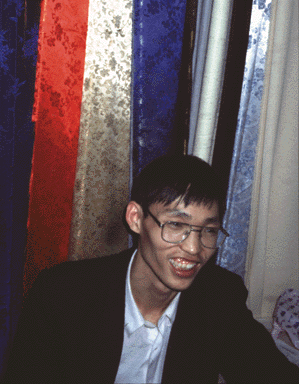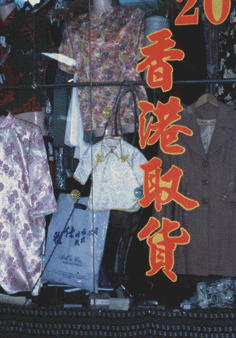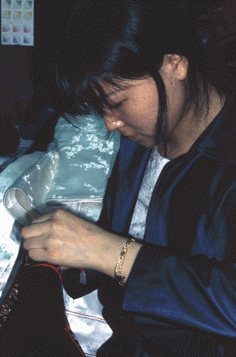
March 1998
Made in Shenzhen
By Chan Chi-ha
Tailor-made clothing is no longer expensive. Tailors in Shenzhen are now
enjoying a mushrooming of their Hong
Kong customer base.
Shenzhen’s tailors are mainly found in Lo Wu Commercial Centre,
adjacent to Lo Wu Railway Station.
“It doesn’t take a long time to go to Shenzhen,” said Ms
Fung Lai Fun, a 46-year-old teacher who has some of her clothes made in Shenzhen. “I
can get to Shenzhen faster during weekdays when fewer people are crossing the
border.”
Lower prices are undeniably the main attraction.

Photos by Chan Chi-ha
“Having clothes made in Shenzhen is cheaper than buying them in Hong
Kong,” said Ms Chu May Nor, a 49-year-old housewife.
On top of lower prices, tailor shops in Shenzhen provide up-to-date
fashion designs.
“There are many different kinds of books, including magazines from
Hong Kong like Elle and Vogue, provided for customers to choose from,” said Ms Chu.
However, the tailors cannot copy all styles of clothing shown in these
books.
Miss Zhao Xue Fang owns Red Leaves Fashion Design in Shenzhen. Said the
24-year-old shop owner: “In such a case, we will tell our customers that we are not
able to produce the fashion they have chosen.”

But sometimes they cannot tell they are unable to make the clothes until
the production phase.
“In those cases, we will stop making it and wait for the customer to
come next time,” said Miss Zhao.
Besides technical problems, insufficient quantities of cloth may also lead
to delays.
“When there is a shortage of cloth, we sometimes try to use similar
cloth instead,” said Miss Zhao. “But this only happens to customers we are
familiar with.”
She said if the customers are not satisfied with the modified clothes,
they can refuse to take them, but there will be no refund of the deposit.
Talking about the difference in quality between these
“made-in-China” fashions and Hong Kong ones, Ms Chu said she preferred the
former.

Ms Fung also agreed that the quality of the cheaper tailor-made fashions
in Shenzhen was acceptable.
But Mr. William Wan, a 43-year-old owner of La Moda Tailor in Hong Kong,
is more critical.
“I would give a D grade for the overall quality of clothes they
make,” said Mr. Wan. “They do not understand the essence of tailoring.
“The tailor must know the customers’ figures very well and be
able to distinguish the good shapes and imperfections of their bodies at first glance.
It’s a matter of feeling and experience,” he explained.
According to Mr. Wan, the short history of Western suits in China means a
lack of sartorial experience.
Another 48-year-old experienced tailor in Hong Kong, Ms Yu Nui, criticized
the practice of division of labour in producing clothes in Shenzhen.
“Tailors there are specialized in sewing particular parts of a shirt.
The collar and sleeves of a shirt are made by different tailors,” said she.
This may affect the style of the shirt.
Tailors in Hong Kong make the whole piece for customers, resulting in
better craftsmanship, according to Ms Yu.
Nevertheless, the lower prices of Shenzhen-made clothes provide a strong
attraction.
“After all, the cheapest tailor-made suit in Hong Kong costs around
$4,000, while it is only $350 in Shenzhen,” said Mr. Wan.
[Culture & Recreation Section Menu]
|


